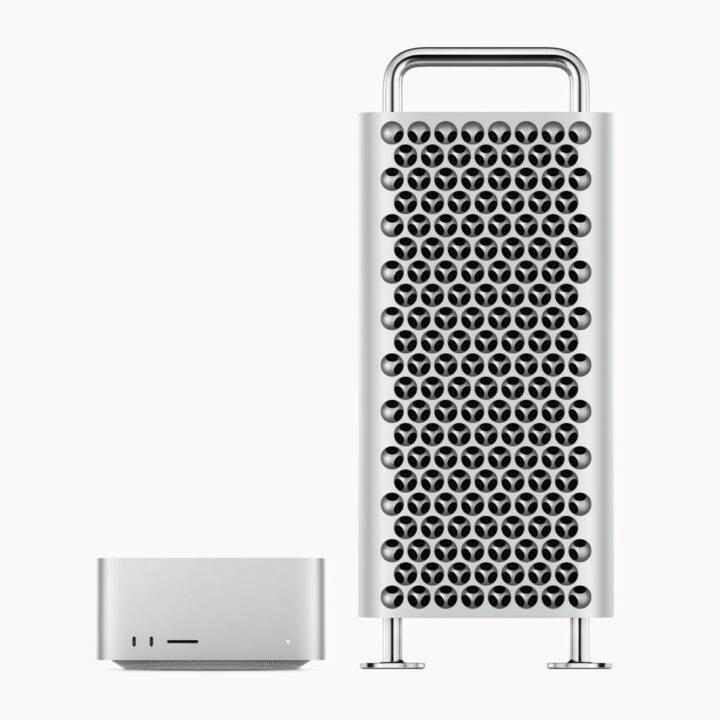Along with a whole bunch of other announcements at the WWDC keynote overnight, Apple revealed its two most powerful Macs to date: the Mac Studio and Mac Pro desktops wielding the new M2 Ultra processor.
There are a couple of notable things to unpack here. For one, it’s the first Mac Pro to use an Apple silicon chip, with the previous model made using Intel. Another important factor is the addition of the M2 Ultra to Apple’s highly-regarded range of M2 chips. It sits above the M2 Pro and M2 Max in performance, which is why Apple’s new desktops are indeed its most powerful yet.
These computers are absolute workhorses designed for high-end processing and graphics-based work. They’re the sort of thing you consider if you do lots of photo and video editing, and need to export high-quality files quickly.
M2 Ultra is one heck of a chip
To get the full picture of how powerful the new Mac Studio and Mac Pro configurations are, we need to first examine the M2 Ultra processor. It packs a beefy 24-core CPU (16 performance cores plus eight efficiency cores) and a mammoth 76-core GPU, with the option of up to 192GB of unified memory.
| M2 Ultra Mac Studio / Mac Pro | M1 Ultra Mac Studio | M2 Max Mac Studio | M2 Pro Mac Mini | |
|---|---|---|---|---|
| CPU | 24 cores | 20 cores | 12 cores | Up to 12 cores |
| GPU | 76 cores | 64 cores | 38 cores | Up to 19 cores |
| Memory | Up to 192GB | Up to 128GB | Up to 96GB | Up to 32GB |
On paper, it looks like a decent step up from the previous-generation M1 Ultra chip. According to Apple’s benchmarking, the M2 Ultra Mac Studio is up to three times faster than the M1 Ultra version. Meanwhile, the new Mac Pro is reportedly three times faster than the previous Intel-based model.
What does this ultimately mean in the real world? More cores and memory equate to greater bandwidth for taking on power and graphics-intensive tasks. Among the examples cited, both the new Mac Studio and Pro configurations offer greater performance across a suite of software. Video editors and visual effects artists see much faster rendering time when using programs like After Effects and Da Vinci Resolve. 3D artists using Octane and developers using Xcode also benefit from faster speeds.
Mac Studio and Mac Pro comparison
Both desktops house near-identical performance specs, so the main differences reside in the form factor and connectivity options. Mac Studio is a cute little box with a small footprint, while the Mac Pro resembles a cheese grater on legs.

Modularity is the main benefit of the Mac Pro over its Studio counterpart thanks to seven PCIe expansion slots. This allows for even more customisation, including additional storage and connecting professional equipment like cameras and monitors. Other advantages the Mac Pro has also include more Thunderbolt 4, USB-A, HDMI and Ethernet ports than the M2 Ultra Mac Studio. Aside from physical ports, they both have Wi-Fi 6E and Bluetooth 5.3 for wireless connectivity.
Each desktop supports up to eight 4K displays, six 6K displays, or three 8K displays for plenty of display options. With all of that considered, both computers are highly powerful, so the deciding factor is how much customisation you need out of the box. For most people in the market, the Studio will be ample, while the aptly-named pro is more for high-end professionals with specific use cases.
M2 Ultra Mac Studio and Mac Pro price and availability
Both devices are available to pre-order now, with Apple setting a 13 June release date. Equipped with an M2 Ultra chip, the Mac Studio starts at $6,599, with an M2 Max model also available from $3,299. At the top end, the M2 Ultra Mac Pro starts at $11,999 for the tower configuration or $12,999 for the server rack version.
They’re both hugely powerful desktops with the price tag to match. We’ll keep you updated with more information as we go hands-on with the new Macs in the coming weeks.








